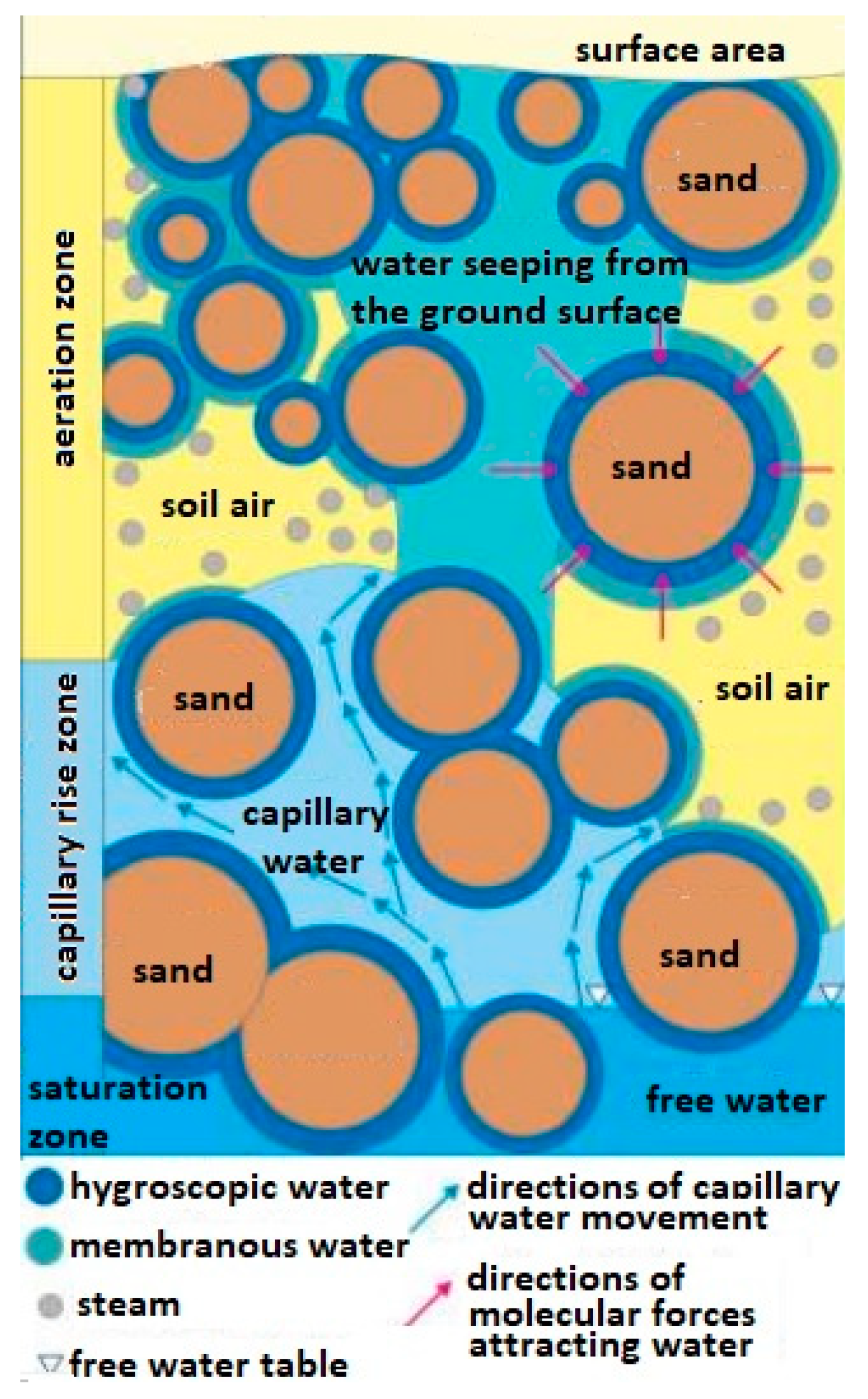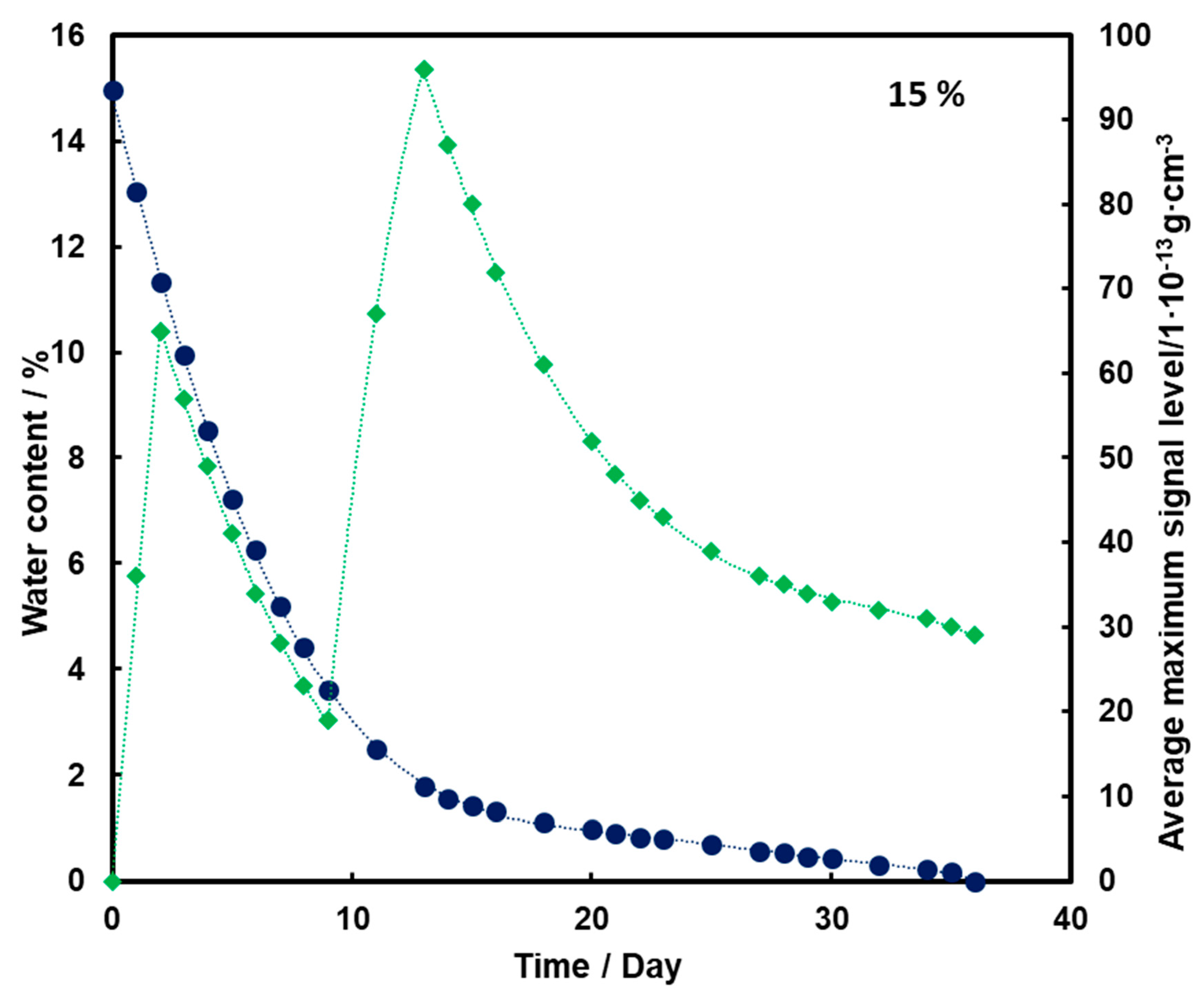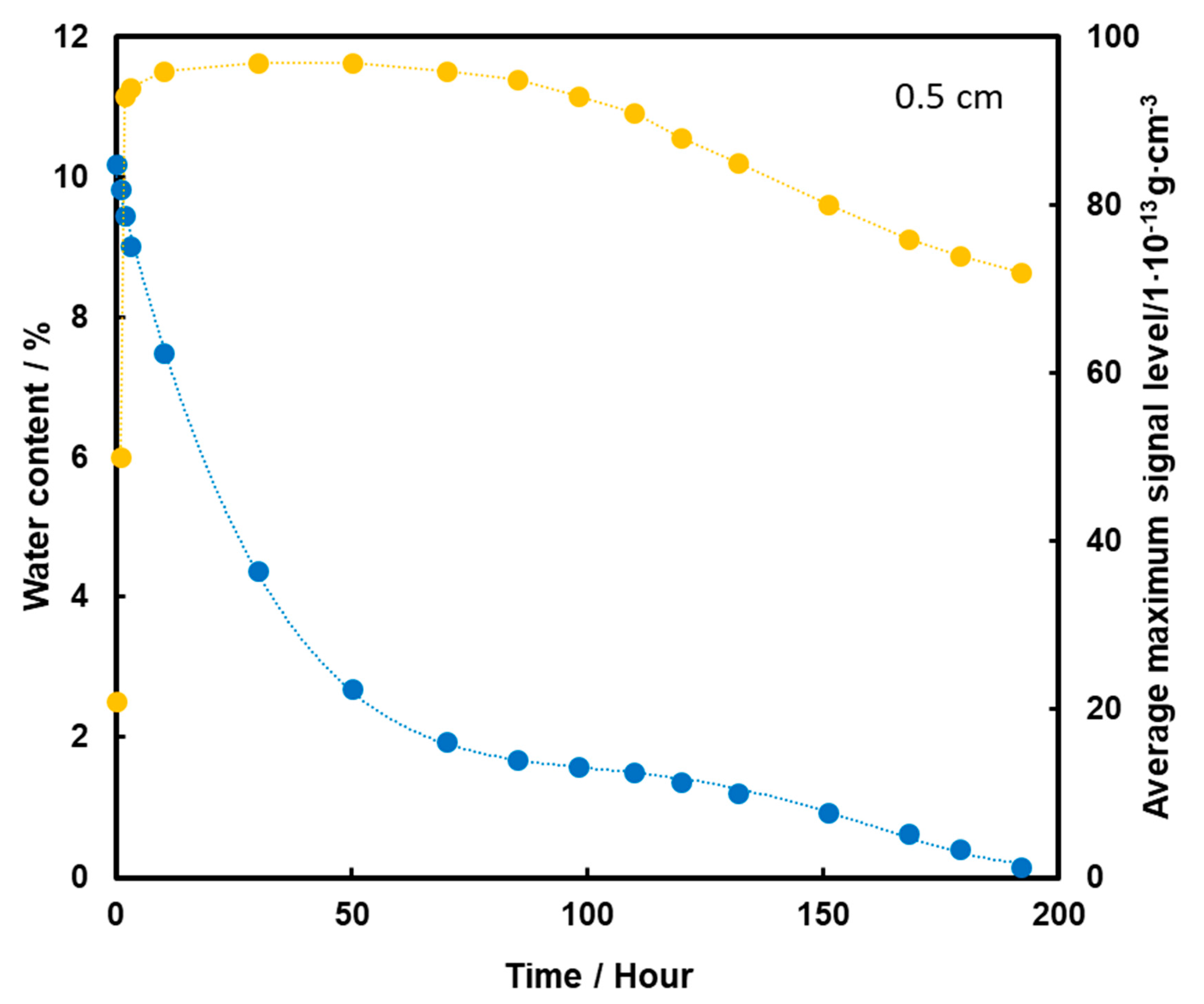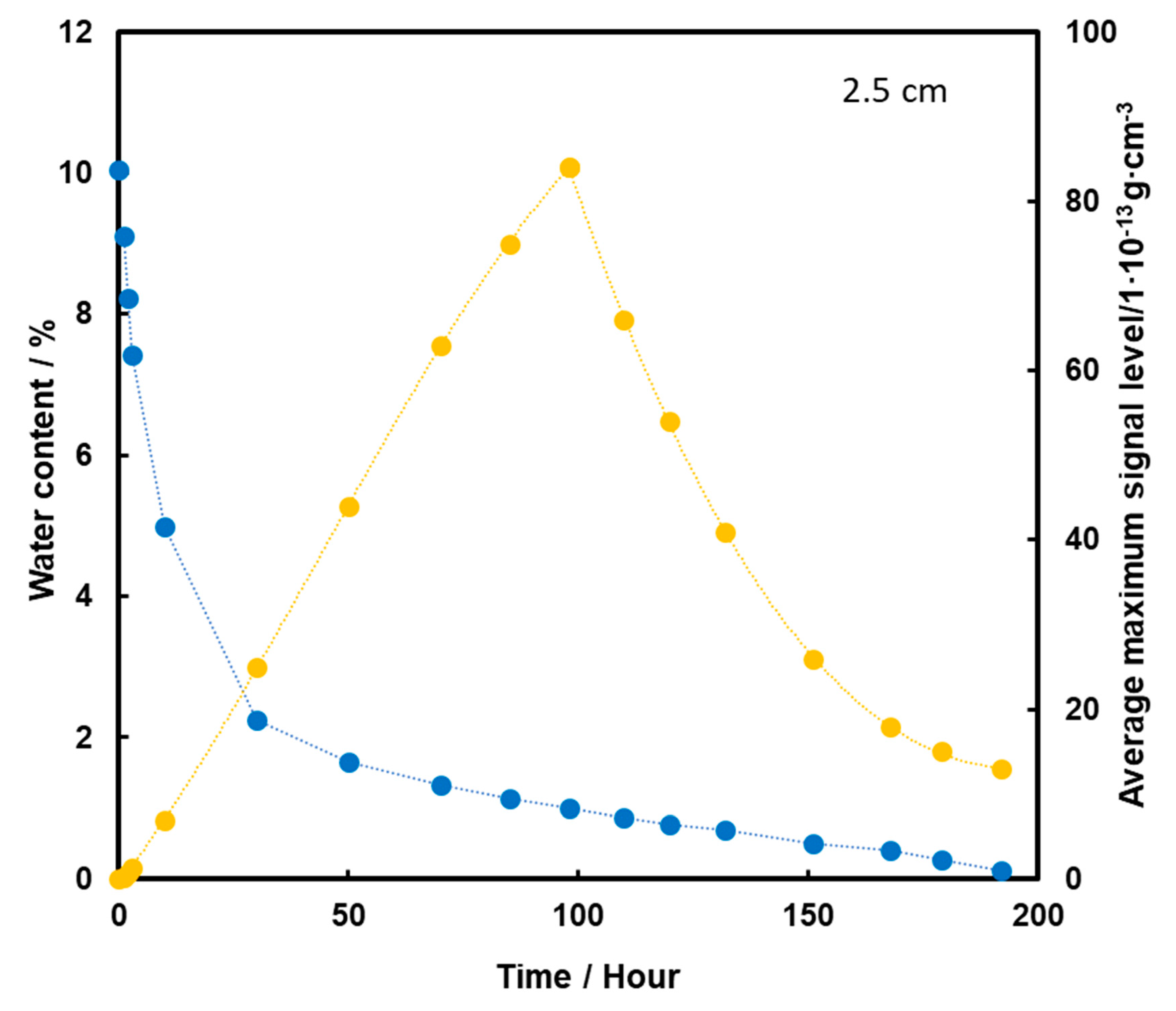The Effect of Soil Moisture on the Ability to Detect TNT Pairs from the Sand Layer in Order to Prevent Environmental Pollution and Groundwater
Abstract
:1. Introduction
2. Experimental
2.1. Materials
2.1.1. Preparation of Sand for Testing
2.1.2. Preparation of Sand Samples
2.1.3. Stage 1—Adaptation of the Workplace
2.1.4. Stage 2—Preparation of Containers
2.1.5. Stage 3—Placing TNT in Containers
2.2. Methods
2.2.1. Detection of Explosives Vapors Using the FAIMS Method—MO-2M Detector
2.2.2. Sand Extract Test
2.2.3. Investigation of the Influence of Substrate Humidity on the Detection of TNT Vapors
- Place the jar on the test stand;
- Bring the detector inlet nozzle closer to 0.5 cm from the sand surface for 10–15 s; and
- Move the detector away from the jar for 10–15 s at a distance not less than 1 m.
2.2.4. Study of the Influence of Temperature on the TNT Detection from under the Sand Layer
- The jars were heated to 50 °C using halogen lamps;
- The jars were placed on the measuring stand;
- Bring the detector inlet nozzle closer to the sand surface, 0.5 cm distance, for 10–15 s; and
- Move the detector away from the jar for 10–15 s at a distance of not less than 1 m.
2.2.5. Analysis of Measurement Errors
3. Results and Discussion
3.1. Investigation of the Influence of Substrate Humidity on the Detection of TNT Vapors
3.2. Study of the Influence of Temperature on the TNT Detection from under the Sand Layer
3.2.1. Ambient Temperature
3.2.2. Increased Temperature
4. Conclusions
Author Contributions
Funding
Institutional Review Board Statement
Informed Consent Statement
Data Availability Statement
Conflicts of Interest
Sample Availability
References
- Fahrenfeld, N.; Zoeckler, J.; Widdowson, A.; Pruden, A. Effect ofbi-ostimulants on 2,4,6-trinitrotoluene (TNT) degradation andbacterial community composition in contaminated aquifersediment enrichments. Biodegradation 2013, 24, 179–190. [Google Scholar] [CrossRef]
- Chien, C.C.; Kao, C.M.; Chen, D.Y.; Chen, S.C.; Chen, C.C. Bio-transformation of trinitrotoluene (TNT) by Pseudomonas spp.iso-lated from a TNT-contaminated environment. Environ. Toxicol. Chem. 2014, 33, 1059–1063. [Google Scholar] [CrossRef] [PubMed]
- Cho, C.; Bae, S.; Lee, W. Enhanced Degradation of TNT and RDXby Bio-reduced Iron Bearing Soil Minerals. Adv. Environ. Res. 2012, 1, 1–14. [Google Scholar] [CrossRef]
- Kulkarni, M.; Chaudhari, A. Microbial remediation of nitroaromatic compounds: An overview. J. Environ. Manag. 2007, 85, 496–512. [Google Scholar] [CrossRef] [PubMed]
- Mercimek, H.A.; Dincer, S.; Guzeldag, G.; Ozsavli, A.; Matyar, F. Aerobic biodegradation of 2,4,6-trinitrotoluene (TNT) by Ba-cillus cereus isolated from contaminated soil. Microb. Ecol. 2013, 66, 512–521. [Google Scholar] [CrossRef]
- Zhang, H.; Feng, L.; Liu, B.; Tong, C.; Lü, C. Conjugation of PPV functionalized mesoporous silica nanoparticles with graphene oxide for facile and sensitive fluorescence detection of TNT in water through FRET. Dyes Pigm. 2014, 101, 122–129. [Google Scholar] [CrossRef]
- Kuperman, R.G.; Checkai, R.T.; Simini, M.; Phillips, C.T.; Kolakowski, J.E.; Lanno, R. Soil properties affect the toxicities of 2,4,6-trinitrotolu-ene (TNT) and hexahydro-1,3,5-trinitro-1,3,5-tria-zine (RDX) to the en-chytraeid worm Enchytraeus crypticus, Environ. Toxicol. Chem. 2013, 32, 2648–2659. [Google Scholar] [CrossRef]
- Maeda, T.; Kadokami, K.; Ogawa, H.I. Characterization of 2,4,6-Trinitrotoluene (TNT)-Metabolizing Bacteria Isolated from TNT-Polluted Soils in the Yamada Green Zone, Kitakyushu. Japan. J. Environ. Biotechnol. 2006, 6, 33–39. [Google Scholar]
- Mercimek, H.A.; Dincer, S.; Guzeldag, G.; Ozsavli, A.; Matyar, F.; Arkut, A.; Kayis, F.; Ozdenefe, M.S. Degradation of 2,4,6-trini-trotoluene by P. aeruginosa and characterization of some me-tabolites. Braz. J. Microbiol. 2015, 46, 103–111. [Google Scholar] [CrossRef] [Green Version]
- Bui, D.N.; Minh, T.T. Investigation of TNT red wastewater treatment technology using the combination of advanced oxidation processes. Sci. Total Environ. 2021, 756, 143852. [Google Scholar] [CrossRef] [PubMed]
- Li, J.; Zhou, Q.; Li, M.; Liu, Y.; Song, Q. Monodisperse amino-modified nanosized zero-valent iron for selective and recyclable removal of TNT: Synthesis, characterization, and removal mechanism. J. Environ. Sci. 2021, 103, 69–79. [Google Scholar] [CrossRef]
- Nhi, B.D. Research on Regenerating Activated Carbon in 2,4,6-Trinitrotoluene (TNT) Explosives Manufacturing Industry by Microwave Radiation and Ionized Nitrogen. Propellants Explos. Pyrotech. 2021, 46, 7–12. [Google Scholar] [CrossRef]
- Tian, R.; Ji, P.; Wang, L.; Zhang, H.; Sun, J. TNT sensor based on accumulation layer and effective distance of FRET mechanism with ultra-high sensitivity. Microchem. J. 2021, 160, 105706. [Google Scholar] [CrossRef]
- MacDonald, J.; Lockwood, J.R.; McFee, J.; Altshuler, T.; Broach, T.; Carin, L.; Harmon, R.; Rappaport, C.; Scott, W.; Weave, R. Alternatives for Landmine Detection; RAND: Santa Monica, CA, USA, 2003. [Google Scholar]
- Leggett, D.C.; Cragin, J.H.; Jenkins, T.F.; Ranney, T. Release of Explosive-Related Vapors from Land Mines; Technical Report ERDC TR-00-5; Cold Regions Research and Engineering Laboratory: Hanover, NH, USA, 2000. [Google Scholar]
- Kjellström, A.H.; Sarholm, L.M. Analysis of TNT and related compounds in vapor and solid phase in different types of soil. In Detection and Remediation Technologies for Mines and Minelike Targets V; Dubey, A.C., Harvey, J.F., Broach, J., Dugan, R.E., Eds.; SPIE: Washington, DC, USA, 2000; pp. 496–503. [Google Scholar]
- George, V.; Jenkins, T.F.; Leggett, D.C.; Cragin, J.H.; Phelan, J.; Oxley, J.; Pennington, J. Progress on Determining the Vapor Signature of a Buried Landmine. In Detection and Remediation Technologies for Mines and Minelike Targets IV; International Society for Optical Engineering: Seattle, WA, USA, 1999; pp. 258–269. [Google Scholar]
- Jenkins, T.F.; Walsh, M.E.; Miyares, P.H.; Kopczynski, J.A.; Ranney, T.A.; George, V.; Pennington, J.; Berry, T.E., Jr. Analysis of Explosives-Related Chemical Signatures in Soil Samples Collected near Buried Land Mines; Technical Report ERDC TR-00-5; U.S. Army Engineer Research and Development Center, Cold Regions Research and Engineering Laboratory: Hanover, NH, USA, 2000. [Google Scholar]
- Leggett, D.C.; Jenkins, T.F.; Murrmann, R.P. Composition of Vapors Evolved from Military TNT as Influenced by Temperature Solid Composition, Age, and Source; Special Report 77–16; U.S. Army Engineer Research and Development Center, Cold Regions Research and Engineering Laboratory: Hanover, NH, USA, 1977. [Google Scholar]
- Schubert, H.; Kuznetsov, A. (Eds.) Detection of Explosives and Landmines, Methods and Field Experience; NATO Science Series II: Mathematics, Physics and Chemistry; Springer: Berlin/Heidelberg, Germany, 2002. [Google Scholar]
- Miyares, P.H.; Jenkins, T.F. Estimating the Half-Lives of Key Components of the Chemical Vapor Signature of Land Mines; Technical Report ERDC/CRREL TR-00-17; U.S. Army Engineer Research and Development Center, Cold Regions Research and Engineering Laboratory: Hanover, NH, USA, 2000. [Google Scholar]
- Caddy, B. Trace evidence—Small samples, big problems. Probl. Forensic Sci. 2001, 46, 24–37. [Google Scholar]
- Jalant, T.; Henchoz, P.; Gallusser, A.; Bonfanti, M.S. The persistence of gunshot residue on shooters’ hands. Sci. Justice 1999, 39, 48–52. [Google Scholar] [CrossRef]
- Janssen, H. Thermal diffusion of water vapour in porous materials: Fact or fiction? Int. J. Heat Mass Transf. 2011, 54, 1548–1562. [Google Scholar] [CrossRef] [Green Version]
- Philip, J.R.; de Vries, D.A. Moisture movement in porous materials under temperature gradient. Trans. Am. Geophys. Union 1957, 38, 222–232. [Google Scholar] [CrossRef]
- Giedrojć, B. Metodyka badań kapilarnego potencjału wodnego zróżnicowania porowatości gleb częściowo zmodyfikowanym kapilarymetrem Sekery. Rocz. Glebozn. 1974, 25, 283–292. [Google Scholar]
- Wysocka, M.; Szypcio, Z.; Tymosiak, D. Capillary rise speed in non-cohesive soils. Civil Environ. Eng. 2013, 4, 167–172. [Google Scholar]
- Coduto, D.P.; Yeung, M.R.; Kitch, W.A. Geotechnical Engineering: Principles and Practices; Pearson: London, UK, 2011. [Google Scholar]
- Jenkins, T.F.; Legget, D.C.; Ranney, T.A. Vapor Signature from Military Explosives—Part I: Vapor Transported from Buried Military-Grade TNT; Special Report 99-21; US Army Corps of Engineers, Cold Regions Research and Engineering Laboratory: Hanover, NH, USA, 1999.
- Phelan, J.M.; Webb, S.W.; Rodacy, P.J.; Barnett, J.L. Environmental Impact to the Chemical Signature Emanating from Buried Ordnance—Final Report; Project CU-1094; Sandia National Laboratories: Albuquerque, NM, USA, 2001.
- Rhykerd, C.L.; Hannum, D.W.; Murray, D.W.; Parmeter, J.E. Guide for the Selection of Commercial Explosives Detection Systems for Law Enforcement Applications; NIJ Guide 100-99; U.S. Department of Justice: Washington, DC, USA, 1999.
- Mostak, P. Vapour and trace detection of explosives. In Vapour and Trace Detection of Explosives for Anti-Terrorism Purposes; Krausa, M., Alekseyvitch Reznev, A., Eds.; Springer: Berlin/Heidelberg, Germany, 2004; pp. 23–30. [Google Scholar]
- Keller, T.; Keller, A.; Tutsch-Bauer, E.; Monticelli, F. Application of ion mobility spectrometry in cases of forensic interest. Forensic Sci. Int. 2006, 161, 130–140. [Google Scholar] [CrossRef]
- Kolakowski, B.M.; Mester, Z. Review of applications of high-field asymmetric waveform ion mobility spectrometry (FAIMS) and differential mobility spectrometry (DMS). Analyst 2007, 132, 842–864. [Google Scholar] [CrossRef] [PubMed]
- Pawłowski, W.; Zalewska, A.; Matyjasek, Ł.; Karpińska, M. The air humidity effect on the detection of TNT, PETN and NG by the FAIMS technique. Sens. Actuat. B Chem. 2017, 247, 343–348. [Google Scholar] [CrossRef]
- Zalewska, A.; Pawłowski, W.; Tomaszewski, W. Limits of detection of explosives as determined with IMS and field asymmetric IMS vapour detectors. Forensic Sci. Int. 2013, 226, 168–172. [Google Scholar] [CrossRef] [PubMed]
- Pettersson, A.; Wallin, S.; Brandner, B.; Eldsäter, C.; Holmgren, E. Explosives Detection—A Technology Inventory; User Report FOI-R-2030-SE; FOI Defence Research Agency, Weapons and Protection: Stockholm, Sweden, 2006. [Google Scholar]
- Shvartsburg, A.A. Differential Ion Mobility Spectrometry, Nonlinear Ion Transport and Fundamentals of FAIMS; CRC Press: Boca Raton, FL, USA, 2009. [Google Scholar]
- SIEBEL; Internal Materials by SIBEL Ltd. MO-2M—Portable Detector of Explosive Vapors. Physical Foundations of NZPI Technology. 2011. Available online: http://www.sibel.info/en/explosives-detectors/mo-2m.html (accessed on 15 July 2020).









Publisher’s Note: MDPI stays neutral with regard to jurisdictional claims in published maps and institutional affiliations. |
© 2021 by the authors. Licensee MDPI, Basel, Switzerland. This article is an open access article distributed under the terms and conditions of the Creative Commons Attribution (CC BY) license (https://creativecommons.org/licenses/by/4.0/).
Share and Cite
Pawłowski, W.; Karpińska, M. The Effect of Soil Moisture on the Ability to Detect TNT Pairs from the Sand Layer in Order to Prevent Environmental Pollution and Groundwater. Molecules 2021, 26, 3908. https://doi.org/10.3390/molecules26133908
Pawłowski W, Karpińska M. The Effect of Soil Moisture on the Ability to Detect TNT Pairs from the Sand Layer in Order to Prevent Environmental Pollution and Groundwater. Molecules. 2021; 26(13):3908. https://doi.org/10.3390/molecules26133908
Chicago/Turabian StylePawłowski, Wojciech, and Monika Karpińska. 2021. "The Effect of Soil Moisture on the Ability to Detect TNT Pairs from the Sand Layer in Order to Prevent Environmental Pollution and Groundwater" Molecules 26, no. 13: 3908. https://doi.org/10.3390/molecules26133908
APA StylePawłowski, W., & Karpińska, M. (2021). The Effect of Soil Moisture on the Ability to Detect TNT Pairs from the Sand Layer in Order to Prevent Environmental Pollution and Groundwater. Molecules, 26(13), 3908. https://doi.org/10.3390/molecules26133908






